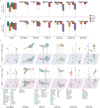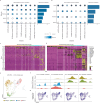scPair: Boosting single cell multimodal analysis by leveraging implicit feature selection and single cell atlases
- PMID: 39548084
- PMCID: PMC11568318
- DOI: 10.1038/s41467-024-53971-2
scPair: Boosting single cell multimodal analysis by leveraging implicit feature selection and single cell atlases
Abstract
Multimodal single-cell assays profile multiple sets of features in the same cells and are widely used for identifying and mapping cell states between chromatin and mRNA and linking regulatory elements to target genes. However, the high dimensionality of input features and shallow sequencing depth compared to unimodal assays pose challenges in data analysis. Here we present scPair, a multimodal single-cell data framework that overcomes these challenges by employing an implicit feature selection approach. scPair uses dual encoder-decoder structures trained on paired data to align cell states across modalities and predict features from one modality to another. We demonstrate that scPair outperforms existing methods in accuracy and execution time, and facilitates downstream tasks such as trajectory inference. We further show scPair can augment smaller multimodal datasets with larger unimodal atlases to increase statistical power to identify groups of transcription factors active during different stages of neural differentiation.
© 2024. The Author(s).
Conflict of interest statement
Figures






References
-
- Kolodziejczyk, A. A., Kim, J. K., Svensson, V., Marioni, J. C. & Teichmann, S. A. The technology and biology of single-cell RNA sequencing. Mol. Cell58, 610–620 (2015). - PubMed
-
- Ziegenhain, C. et al. Comparative analysis of single-cell RNA sequencing methods. Mol. Cell65, 631–643.e4 (2017). - PubMed
-
- Karemaker, I. D. & Vermeulen, M. Single-cell DNA methylation profiling: technologies and biological applications. Trends Biotechnol.36, 952–965 (2018). - PubMed
-
- Clark, S. J. et al. Genome-wide base-resolution mapping of DNA methylation in single cells using single-cell bisulfite sequencing (scBS-seq). Nat. Protoc.12, 534–547 (2017). - PubMed
Publication types
MeSH terms
Substances
Associated data
- Actions
- Actions
- Actions
- Actions
- Actions
- Actions

